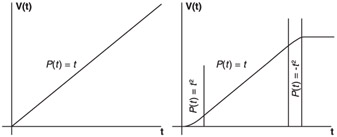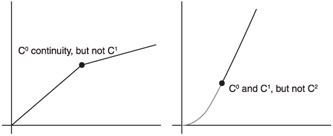Web Sites
| | | ||||||||||||||||||||||||||
| | ||||
| | |||||
Joining Curves and Continuity
Sometimes, you will want a curve to have different properties in different intervals like the one shown on the right side of Figure 1.8.

Figure 1.8: Two graphs of distance over time.
The left side shows an object moving at a constant speed. The problem is that it is a little too constant. The leftmost graph implies that the object instantaneously accelerated to the constant speed and then instantly decelerated at the end of the interval. The rightmost graph shows a more realistic example. The object accelerates smoothly to the constant speed and then later smoothly decelerates.
When you are joining multiple curves, one of the most important properties is continuity. You can talk about several orders of continuity and each level says something about the transition between the two curves. Curves with zero-order continuity are continuous graphs with no breaks. Curves with first-order continuity have continuous first derivatives (the graphs of their slopes are continuous). Curves with second-order continuity have continuous second derivatives, and so on. The orders of continuity are denoted as C , C 1 , and so on.
In most cases, zero-and first-order continuities are extremely important because they have the most visible effect at the point where the curves are joined. Higher orders of continuity are generally less important because it isn't as noticeable when the higher derivatives of the curves do not match. Figure 1.9 shows two examples of curves joined with various forms of continuity. Notice that one order of continuity does not necessarily imply another.

Figure 1.9: Examples of curves with different orders of continuity.
As you can see, C continuity means that there is no gap between the two curves. The curves are joined, but there can be a kink at the join. An object moving along that path would experience an instantaneous change in velocity at the join. C 1 continuity means that the slopes of both curves match where they join, producing a smooth transition. An object moving along the path would experience a smoother change in velocity. Higher orders of continuity might be important in terms of velocity and acceleration, but their effects are typically less visually apparent.
This concept will become much more important when I get into Bezier curves and splines. In the meantime, experiment with joining some curves so that you can get a better sense of what needs to be done to establish different levels of continuity.
| | |||||
| | ||||
| | |||||
EAN: 2147483647
Pages: 104
- Using SQL Data Definition Language (DDL) to Create Data Tables and Other Database Objects
- Using Data Control Language (DCL) to Setup Database Security
- Working with Comparison Predicates and Grouped Queries
- Writing External Applications to Query and Manipulate Database Data
- Exploiting MS-SQL Server Built-in Stored Procedures